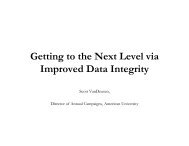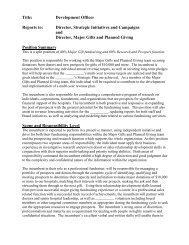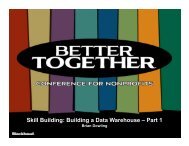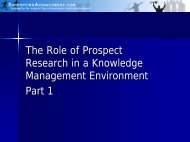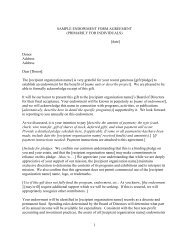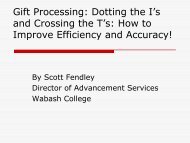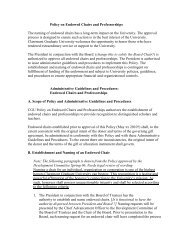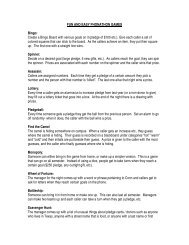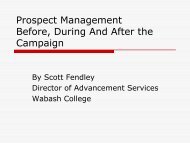The Role of Prospect Research in a Knowledge Management ...
The Role of Prospect Research in a Knowledge Management ...
The Role of Prospect Research in a Knowledge Management ...
Create successful ePaper yourself
Turn your PDF publications into a flip-book with our unique Google optimized e-Paper software.
<strong>The</strong> <strong>Role</strong> <strong>of</strong> <strong>Prospect</strong> <strong>Research</strong> <strong>in</strong> a<br />
<strong>Knowledge</strong> <strong>Management</strong> Environment<br />
From <strong>The</strong>ory to Practice<br />
John Hostler<br />
Executive Director, Advancement Services<br />
Columbia College Chicago<br />
CASE Annual Conference for Senior Advancement Services Pr<strong>of</strong>essionals<br />
April 20-22, 2005<br />
Sheraton Vancouver Wall Centre<br />
Vancouver, BC, Canada
<strong>Prospect</strong> <strong>Research</strong> as Distributed Practice (1)<br />
• <strong>Prospect</strong> research sources:<br />
– Development <strong>of</strong>ficers and other IA personnel<br />
– Non-advancement personnel<br />
– External contacts<br />
– Secondary and tertiary <strong>in</strong>formation sources<br />
– <strong>The</strong> <strong>in</strong>stitution’s various data repositories<br />
• In a strong KM environment:<br />
– Few barriers isolate data and <strong>in</strong>formation ma<strong>in</strong>ta<strong>in</strong>ed<br />
by researchers, development <strong>of</strong>ficers, and<br />
advancement services personnel<br />
– Advancement services activities, prospect<br />
management, and prospect research are <strong>in</strong>extricably<br />
l<strong>in</strong>ked
<strong>Prospect</strong> <strong>Research</strong> as Distributed Practice (2)<br />
• Internal Tra<strong>in</strong><strong>in</strong>g and Policy Adherence<br />
– To champion KM, IA personnel must “lead by<br />
example” by be<strong>in</strong>g:<br />
• Well-versed <strong>in</strong> KM-related research policies and procedures<br />
• Pr<strong>of</strong>icient <strong>in</strong> the use <strong>of</strong> relevant tools/systems<br />
• Actively adher<strong>in</strong>g to the same processes be<strong>in</strong>g requested <strong>of</strong><br />
others.<br />
– <strong>Research</strong> request protocols<br />
– Location <strong>of</strong> research <strong>in</strong>formation (<strong>in</strong>ternally and externally)<br />
– Decentralized data entry (prospect/trip notes, proposal details, etc.)<br />
– Moves management status track<strong>in</strong>g guidel<strong>in</strong>es/responsibilities<br />
– Capacity and aff<strong>in</strong>ity rat<strong>in</strong>g guidel<strong>in</strong>es/responsibilities
<strong>Prospect</strong> <strong>Research</strong> as Distributed Practice (3)<br />
• <strong>Knowledge</strong> Harvest<strong>in</strong>g: Emphasiz<strong>in</strong>g the Tacit<br />
– Pr<strong>in</strong>t and electronic <strong>in</strong>formation sources <strong>of</strong>ten pa<strong>in</strong>t a<br />
fragmented & mislead<strong>in</strong>g picture <strong>of</strong> major prospects<br />
• Explore tacit knowledge available from trustees, development<br />
<strong>of</strong>ficers, other <strong>in</strong>ternal personnel, and even external parties<br />
• Establish networks and processes to ethically extract, process,<br />
document, and distribute human <strong>in</strong>telligence from tacit sources<br />
– Peer screen<strong>in</strong>gs (face-to-face and survey-based)<br />
– Development strategy & PERC meet<strong>in</strong>gs<br />
– Proprietary contact networks<br />
– Policies and procedures for approach<strong>in</strong>g deans, chairs, etc.
<strong>Research</strong> Components <strong>of</strong> Global Info Flows (1)<br />
• <strong>Research</strong> Data Integration<br />
– Utilize IA’s central database as the primary research <strong>in</strong>formation<br />
repository and report<strong>in</strong>g tool<br />
• Direct flow to this database allows anyone with system access to view<br />
and retrieve <strong>in</strong>formation on demand<br />
– Elim<strong>in</strong>ates need to reference spl<strong>in</strong>tered data sources (e.g., the database and paper<br />
pr<strong>of</strong>iles) for piecemeal prospect pr<strong>of</strong>iles<br />
– Organization-wide research aggregation efforts cover:<br />
• <strong>Prospect</strong>/trip notes<br />
• Contacts (by phone, mail, email, etc.) and responses<br />
• Proposal details<br />
• Moves management status (cultivation stage)<br />
• Capacity and aff<strong>in</strong>ity rat<strong>in</strong>gs<br />
• Basic demographics and giv<strong>in</strong>g activity<br />
• Summary <strong>of</strong> current relationship/connection with the organization<br />
• Other <strong>in</strong>dicators <strong>of</strong> <strong>in</strong>terest, l<strong>in</strong>kage, and capacity (external<br />
philanthropic activity, known hobbies, committee appo<strong>in</strong>tments, etc.)
<strong>Prospect</strong> <strong>Research</strong> Information Flow<br />
Structured to Promote Shar<strong>in</strong>g<br />
News alerts /<br />
Ad Hoc Info<br />
Lead reservoir<br />
(“Expansion<br />
List”)<br />
<strong>Prospect</strong> /<br />
Development<br />
Info<br />
(Institution-wide<br />
<strong>in</strong>put)<br />
<strong>Prospect</strong> Visits<br />
(Strategy<br />
development &<br />
fundraiser activity)<br />
<strong>Prospect</strong><br />
<strong>Research</strong>[ers]<br />
(Detailed pr<strong>of</strong>ile<br />
<strong>in</strong>formation)<br />
Central IA<br />
Database<br />
PERC/Strategy<br />
Meet<strong>in</strong>gs<br />
(Hub <strong>of</strong> tacit<br />
knowledge)<br />
External Info<br />
(news, “rich<br />
lists,” etc.)<br />
Peer Screen<strong>in</strong>g<br />
Surveys<br />
(Key prospects<br />
reviewed by<br />
Trustees)<br />
Mass<br />
Cultivation/Solic<br />
itation Activities<br />
(Mail<strong>in</strong>gs, events)<br />
Suspect M<strong>in</strong><strong>in</strong>g<br />
(“M<strong>in</strong><strong>in</strong>g List”)
<strong>Research</strong> Components <strong>of</strong> Global Info Flows (2)<br />
• CASS framework (Controlled Access Self-Service)<br />
– Transparency is critical –little (if any) research data should be<br />
hidden from persons <strong>in</strong>volved <strong>in</strong> cultivation efforts<br />
• “Controlled Access” partially decentralized data entry<br />
• “Self Service” ability to locate and retrieve research <strong>in</strong>formation easily<br />
and efficiently.<br />
– Use bus<strong>in</strong>ess processes to force relevant <strong>in</strong>formation through the<br />
central database (from across the <strong>in</strong>stitution)<br />
– Tra<strong>in</strong> fundraisers across the <strong>in</strong>stitution to:<br />
• Query, export, and report <strong>in</strong>formation relevant to their respective<br />
development activities<br />
• Enter constituent notes, proposal <strong>in</strong>formation, capacity/aff<strong>in</strong>ity rat<strong>in</strong>gs,<br />
status codes, etc.
<strong>Prospect</strong> <strong>Research</strong> <strong>in</strong> the <strong>Knowledge</strong> Cycle (1)<br />
• <strong>The</strong> traditional knowledge cycle model can be<br />
used to identify <strong>in</strong>formation and process gaps at<br />
each stage
<strong>Prospect</strong> <strong>Research</strong> <strong>in</strong> the <strong>Knowledge</strong> Cycle<br />
Representative sample <strong>of</strong> elements & activities<br />
•Lead development (“prospect<strong>in</strong>g”)<br />
•Data m<strong>in</strong><strong>in</strong>g (prospect ID)<br />
•<strong>Prospect</strong> research<br />
•Strategy formulation<br />
•Cultivation / solicitation<br />
•Enrichment <strong>of</strong> tacit/<strong>in</strong>stitutional<br />
knowledge<br />
•<strong>Prospect</strong> pyramid dev.<br />
•Adv. goal sett<strong>in</strong>g<br />
Application,<br />
•Moves management<br />
Retention &<br />
•<strong>Research</strong> requests<br />
Needs Assmt<br />
•KM process gap ID<br />
Identification<br />
Creation &<br />
Acquisition<br />
ACKM Assessment<br />
& Goal Sett<strong>in</strong>g for<br />
<strong>Prospect</strong> <strong>Research</strong><br />
Capture &<br />
Storage<br />
•<strong>Research</strong>/IA <strong>in</strong>fo<br />
•Non-IA notes<br />
•Internal meet<strong>in</strong>g notes<br />
•Trip notes / moves<br />
•Documented strategies<br />
•M<strong>in</strong><strong>in</strong>g List<br />
•Expansion List<br />
•Pr<strong>of</strong>ile distr./pub.<br />
•Survey distr./pub.<br />
•Lead distribution / assignment<br />
•News / ad hoc <strong>in</strong>fo distr./pub.<br />
•PERC/strategy meet<strong>in</strong>gs<br />
Deployment<br />
/<br />
Distribution<br />
Organization<br />
&<br />
Transformtn<br />
•Data aggregation (e.g., note<br />
consolidation)<br />
•Synthesis (capacity, aff<strong>in</strong>ity, etc.)<br />
•Push-button pr<strong>of</strong>iles<br />
•Peer screen<strong>in</strong>g surveys
<strong>Prospect</strong> <strong>Research</strong> <strong>in</strong> the <strong>Knowledge</strong> Cycle (2)<br />
• <strong>Research</strong> Information Mapp<strong>in</strong>g -Mapp<strong>in</strong>g<br />
research data elements aga<strong>in</strong>st the knowledge cycle,<br />
and <strong>in</strong>tegrat<strong>in</strong>g this map <strong>in</strong>to policies and procedures<br />
documentation:<br />
– Forces a de facto “situation analysis” <strong>of</strong> research operations<br />
– Inventories <strong>in</strong>formation sources and optimizes “the mix”<br />
• Identifies and elim<strong>in</strong>ates <strong>in</strong>formation gaps and redundancies<br />
– Formalizes sourc<strong>in</strong>g, pro<strong>of</strong><strong>in</strong>g, data entry, transformation, and<br />
distribution responsibilities<br />
– Optimizes sourc<strong>in</strong>g, pro<strong>of</strong><strong>in</strong>g, data entry, transformation, and<br />
distribution processes<br />
• Identifies and elim<strong>in</strong>ates critical process gaps and redundancies<br />
• <strong>The</strong> illustrative <strong>in</strong>formation map depicted next, though<br />
not comprehensive, is <strong>in</strong>tended to provide a start<strong>in</strong>g<br />
po<strong>in</strong>t for the design <strong>of</strong> <strong>in</strong>stitution-specific models…
<strong>Research</strong> Info Map Model – Part 1<br />
Aff<strong>in</strong>ity<br />
Interest<br />
L<strong>in</strong>kage<br />
Capacity<br />
Identification, Acquisition, and Creation<br />
Data Primary Source(s) Human Filter(s) Data Entry/Import<br />
Primary Storage<br />
Location<br />
1. Cultivation Cycle Stage 1. <strong>Prospect</strong> Mgr / DO's 1. <strong>Prospect</strong> Mgr 1. <strong>Prospect</strong> Mgr 1. CDB - Prsp Status Field<br />
2. Trip Notes 2. DO's / Non-IA Fac/Staff 2. None 2. DO's / Non-IA Fac/Staff 2. CDB - Notes Fields<br />
3. Aff<strong>in</strong>ity Rat<strong>in</strong>gs 3. <strong>Research</strong>ers / DO's 3. <strong>Research</strong> Mgr & <strong>Prospect</strong><br />
Mgrs<br />
3. <strong>Research</strong>ers & <strong>Prospect</strong> Mgrs 3. CDB - Prsp Rat<strong>in</strong>gs Fields<br />
1. Appeal/Invitation<br />
1. Event Mgrs / Adv Svcs 1. Adv. Svcs Mgr 1. Event Coord. / Adv. Svcs 1. CDB - Appeals Section<br />
Communications & Responses<br />
Associate<br />
2. Event Participation 2. Event Mgrs / Adv Svcs 2. Adv. Svcs Associate 2. Event Coord. / Adv. Svcs 2. CDB - Appeals Section<br />
Associate<br />
3. Volunteer Activities 3. Constituent Relations / Non- 3. Data Integrity Mgr 3. Adv. Svcs Associate 3. CDB - Volunteer Attributes<br />
IA Fac/Staff<br />
4. Fund<strong>in</strong>g Interests 4. <strong>Research</strong>ers / DO's / Grants 4. <strong>Research</strong>ers 4. <strong>Research</strong>ers 4. CDB - Prsp Interest Section<br />
Adm<strong>in</strong> / Data Vendor<br />
5. Personal/Pr<strong>of</strong> Interests 5. <strong>Research</strong>ers / DO's / Non-IA 5. <strong>Research</strong>ers 5. <strong>Research</strong>ers 5. CDB - Interest Attributes<br />
Fac/Staff<br />
1. Direct Instit. Relationships 1. <strong>Research</strong>ers / DO's / Trustees 1. <strong>Research</strong>ers 1. <strong>Research</strong>ers 1. CDB - Relationships Section;<br />
(CNP Surveys)<br />
Secondary Solicitor Assignment<br />
2. Indirect Instit. Relationships 2. <strong>Research</strong>ers / DO's 2. <strong>Research</strong>ers 2. <strong>Research</strong>ers 2. CDB - Relationships Section<br />
1. Hard F<strong>in</strong>ancial Indicators 1. <strong>Research</strong>ers / Screen<strong>in</strong>g<br />
Vendor<br />
Capture/ Storage<br />
1. <strong>Research</strong>ers 1. <strong>Research</strong>ers 1. CDB - F<strong>in</strong>ancials Section<br />
2. Trip Notes 2. DO's / Non-IA Fac/Staff 2. None 2. DO's / Non-IA Fac/Staff 2. CDB - Notes Fields<br />
3. Capcity Rat<strong>in</strong>gs 3. <strong>Research</strong>ers / DO's 3. <strong>Research</strong> Mgr / <strong>Prospect</strong> Mgrs 3. <strong>Research</strong>ers / <strong>Prospect</strong> Mgrs 3. CDB - Prsp Rat<strong>in</strong>gs Fields<br />
Analytical<br />
<strong>Prospect</strong><br />
Pr<strong>of</strong>iles<br />
1. Basic Demographics 1. Adv. Svcs / Screen<strong>in</strong>g Vendor 1. Data Integrity Mgr 1. Adv. Svcs Associate 1. CDB - Prsp Accounts<br />
2. Consolidated <strong>Prospect</strong> Info &<br />
Analysis<br />
2. <strong>Research</strong>ers 2. <strong>Research</strong> Mgr 2. <strong>Research</strong>ers 2. CDB - Pr<strong>of</strong>ile Notes Fields<br />
Strategy<br />
1. Broad Cultivation Strategies 1. <strong>Prospect</strong> Mgr / DO's 1. <strong>Prospect</strong> Mgr 1. <strong>Prospect</strong> Mgr / DO's 1. CDB - Notes Fields<br />
2. Proposal Info (Major Gifts & 2. <strong>Prospect</strong> Mgr / DO's / Grants 2. <strong>Prospect</strong> Mgr / Grants Adm<strong>in</strong> 2. DO's / Grants Adm<strong>in</strong> 2. CDB - Prsp Proposals Section<br />
Grants)<br />
Adm<strong>in</strong>
<strong>Research</strong> Info Map Model – Part 2<br />
Transformation Distribution Application<br />
Aff<strong>in</strong>ity<br />
Interest<br />
Aff<strong>in</strong>ity Assessment Models;<br />
<strong>Prospect</strong> Activity Monitors (for<br />
review & revision); Crystal<br />
Report-Based Aff<strong>in</strong>ity Analysis &<br />
Matrices<br />
Direct System Access; Push-<br />
Button Crystal Report<strong>in</strong>g; Real-<br />
Time Capacity Alerts (manual<br />
push); PERC Mtgs<br />
Cultivation / Solicitation;<br />
Enrichment <strong>of</strong> Institutional<br />
knowledge; <strong>Prospect</strong> Pyramid<br />
Development; Goal Sett<strong>in</strong>g;<br />
Moves <strong>Management</strong><br />
L<strong>in</strong>kage<br />
Capacity<br />
Capacity Assessment Models;<br />
<strong>Prospect</strong> Activity Monitors (for<br />
review & revision); Crystal<br />
Report-Based Capacity Analysis<br />
& Matrices<br />
Analytical<br />
<strong>Prospect</strong><br />
Pr<strong>of</strong>iles<br />
<strong>Research</strong>er Consolidation &<br />
Analysis; Crystal Report-Based<br />
Pr<strong>of</strong>iles (Push-Button)<br />
Email - To Requestor & all<br />
Development Personnel; Hard<br />
Copy via PERC Mtgs; Push-<br />
Button Crystal Report<strong>in</strong>g<br />
Strategy<br />
<strong>Prospect</strong> Activity Monitors &<br />
Proposal Status Reports (for<br />
review & revision)<br />
Direct System Access; Push-<br />
Button Crystal Report<strong>in</strong>g; PERC<br />
Mtgs; Dev Strategy Mtgs
Information <strong>Management</strong> Tools and Tactics (1)<br />
• Multi-Level Notes – Note types designed for<br />
specific content and user segments<br />
– Note types designated for researchers are used to<br />
aggregate <strong>in</strong>formation from multiple sources <strong>in</strong> pr<strong>of</strong>ilefriendly<br />
form<br />
• Can be “flowed” <strong>in</strong>to push-button pr<strong>of</strong>ile reports<br />
– Other note types are used by personnel throughout the<br />
organization<br />
• Used to “feed” research notes<br />
– Still others might house content downloaded from<br />
external sources such as onl<strong>in</strong>e communities<br />
• Used to “feed” research notes
Information <strong>Management</strong> Tools and Tactics (2)<br />
• Block Pr<strong>of</strong>ile Libraries – A special “note level”<br />
consist<strong>in</strong>g <strong>of</strong> one-paragraph constituent bios<br />
– Included <strong>in</strong> event attendee reports to prep development <strong>of</strong>ficers<br />
– Culled and distilled from <strong>in</strong>formation gathered across the<br />
organization<br />
– May cue requests for more extensive research workups<br />
• Lead Reservoirs - Lists <strong>of</strong> high-level suspects for<br />
which no <strong>of</strong>ficial record has yet been created<br />
– Ma<strong>in</strong>ta<strong>in</strong>ed outside the central database<br />
– Cont<strong>in</strong>uously fed by <strong>in</strong>ternal and external sources<br />
– Used to track research activities to which each suspect has been<br />
exposed* (PERC meet<strong>in</strong>gs, peer screen<strong>in</strong>g surveys, etc.), thereby<br />
avoid<strong>in</strong>g redundant coverage<br />
* Tracked <strong>in</strong> the database for exist<strong>in</strong>g records
Information <strong>Management</strong> Tools and Tactics (3)<br />
• M<strong>in</strong><strong>in</strong>g Lists - Filter previously unknown suspects<br />
from the central database based on job title, giv<strong>in</strong>g<br />
history, zip code, capacity rat<strong>in</strong>g, l<strong>in</strong>kage <strong>in</strong>tensity (e.g.,<br />
trustee relationships), etc.<br />
– Enabled by aggregated data<br />
– Suspects are featured <strong>in</strong> peer screen<strong>in</strong>gs, dvlpt meet<strong>in</strong>gs, etc.<br />
– Data markers (such as prospect manager assignments) exclude<br />
the <strong>in</strong>vestigated records from future m<strong>in</strong><strong>in</strong>g lists<br />
• <strong>Prospect</strong> Activity Monitors - Detail notes,<br />
<strong>in</strong>teractions, proposals, gifts, and other <strong>in</strong>formation<br />
added to assigned constituents’ accounts<br />
– Enabled by aggregated data<br />
– Keep prospect mgrs abreast <strong>of</strong> activities surround<strong>in</strong>g prospects<br />
– Used to trigger pr<strong>of</strong>iles, facilitate note audit<strong>in</strong>g/sanitization,<br />
serve as “safety nets” for prospect clearance, etc.
Balanc<strong>in</strong>g “Push” and “Pull” Communication<br />
Tactics<br />
• Information that changes only sporadically and/or <strong>in</strong><br />
unknown locations should be “pushed” to the end<br />
user. Users may be required to “pull” <strong>in</strong>formation <strong>of</strong><br />
strong <strong>in</strong>terest, forc<strong>in</strong>g system <strong>in</strong>teraction and rais<strong>in</strong>g<br />
system comfort levels.<br />
–PUSHpr<strong>of</strong>iles for newly researched <strong>in</strong>dividuals across the<br />
development operation<br />
–PUSHunscheduled <strong>in</strong>formation updates via regularly distributed<br />
<strong>Prospect</strong> Activity Monitors<br />
– For clearance and approval approval purposes, decentralized<br />
units may be required to PULL lists <strong>of</strong> their prospects appear<strong>in</strong>g<br />
on others’ event <strong>in</strong>vitation lists
<strong>Prospect</strong> <strong>Research</strong> Units as “Learn<strong>in</strong>g<br />
Organizations” (1)<br />
• Skilled at:<br />
– Creat<strong>in</strong>g, acquir<strong>in</strong>g, and transferr<strong>in</strong>g knowledge<br />
– Cont<strong>in</strong>ually extract<strong>in</strong>g knowledge from collective<br />
experience<br />
– Leverag<strong>in</strong>g knowledge for positive organizational<br />
change<br />
• Committed to:<br />
– Regularly evaluat<strong>in</strong>g common goals and objectives<br />
– Cont<strong>in</strong>uously develop<strong>in</strong>g more effective and efficient<br />
ways <strong>of</strong> meet<strong>in</strong>g them
<strong>Prospect</strong> <strong>Research</strong> Units as “Learn<strong>in</strong>g<br />
Organizations” (2)<br />
• Sample practices:<br />
– Cultivat<strong>in</strong>g <strong>in</strong>ternal “communities <strong>of</strong> practice” by encourag<strong>in</strong>g<br />
researchers to cont<strong>in</strong>ually share evolv<strong>in</strong>g expertise, best practices,<br />
and <strong>in</strong>formation sources<br />
• L<strong>in</strong>ked to external communities via pr<strong>of</strong>essional associations (e.g.,<br />
APRA), listservs, etc.<br />
–Ground<strong>in</strong>g best practices management <strong>in</strong> comprehensive,<br />
cont<strong>in</strong>ually updated, & effectively communicated policies and<br />
procedures documentation<br />
– Provid<strong>in</strong>g basic research tra<strong>in</strong><strong>in</strong>g for all <strong>in</strong>terested development<br />
personnel<br />
• Relieves researchers <strong>of</strong> early-stage qualification burdens<br />
• Provides a forum for promot<strong>in</strong>g knowledge harvest<strong>in</strong>g techniques (e.g.,<br />
elicitation) suited to fundraisers’ face-to-face <strong>in</strong>teractions<br />
– Collaboratively develop<strong>in</strong>g and clearly communicat<strong>in</strong>g common<br />
research goals and objectives
Align<strong>in</strong>g <strong>Research</strong> and Organizational Goals<br />
• <strong>Research</strong> objectives and goals should be<br />
explicitly tied to those <strong>of</strong> the organization,<br />
preferably <strong>in</strong> the clear and concise context <strong>of</strong> a<br />
plann<strong>in</strong>g grid (next slide)<br />
• A work<strong>in</strong>g grid would consist <strong>of</strong> a much larger<br />
goal/objective set(!)
Align<strong>in</strong>g <strong>Research</strong> and Organizational Goals<br />
Note: many-to-many relationship between objectives & goals<br />
<strong>Research</strong><br />
Objective<br />
<strong>Research</strong> Goal<br />
Organization<br />
Objective<br />
Organization<br />
Goal<br />
Implement direct-todatabase<br />
policy for<br />
archiv<strong>in</strong>g and track<strong>in</strong>g<br />
prospect research<br />
<strong>in</strong>formation<br />
Enable broad access to<br />
prospect <strong>in</strong>formation to<br />
maximize potency <strong>of</strong><br />
development efforts<br />
Increase scholarship<br />
fund<strong>in</strong>g by an average <strong>of</strong><br />
8% annually<br />
Make College affordable<br />
for students at all<br />
<strong>in</strong>come levels<br />
Implement quarterly<br />
survey-based peer<br />
screen<strong>in</strong>g program for<br />
trustees<br />
Optimize ability to<br />
identify prospects for<br />
major event<br />
sponsorships<br />
Launch an annual<br />
signature fund rais<strong>in</strong>g<br />
event fully sponsored by<br />
high-level constituents<br />
Build a reputation for<br />
excellence and<br />
<strong>in</strong>novation <strong>in</strong> arts and<br />
media education
<strong>Research</strong> KM Implementation Model<br />
Global model applied to research component <strong>of</strong> ACKM <strong>in</strong>itiative<br />
1<br />
2<br />
3<br />
4<br />
5<br />
6<br />
7<br />
Situation Analysis & Basel<strong>in</strong>e Preparation<br />
Introduce KM concepts, explore organizational benefits, and beg<strong>in</strong> to<br />
“retool” the research area<br />
Prelim<strong>in</strong>ary Promotion & Strategy Development<br />
Build networks <strong>of</strong> key personnel and identify potential research projects<br />
Design & Launch<br />
Embed KM <strong>in</strong> the research model; design, conduct, and evaluate pilot<br />
projects<br />
Mobilization <strong>of</strong> Support<br />
Consolidate top-level support; structure benefits & <strong>in</strong>centives to<br />
promote participation / buy-<strong>in</strong><br />
Expansion & Entrenchment<br />
Mobilize required resources; develop and implement pilot expansion<br />
strategies; fuse KM practices to everyday research processes<br />
Institutionalization<br />
Further embed KM-based research <strong>in</strong> the organization’s bus<strong>in</strong>ess<br />
model, org structure, budgets, adm<strong>in</strong>istrative practices, and <strong>in</strong>centives<br />
Monitor<strong>in</strong>g, Assessment, & Adjustment<br />
Monitor the health <strong>of</strong> <strong>in</strong>dividual research projects and the global KMbased<br />
research <strong>in</strong>itiative, adjust<strong>in</strong>g as necessary



